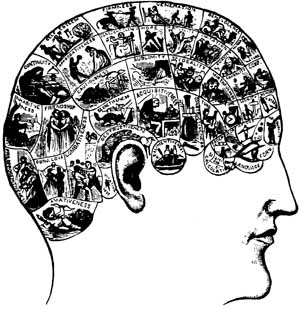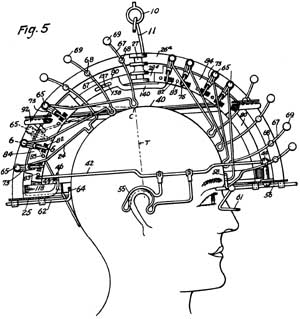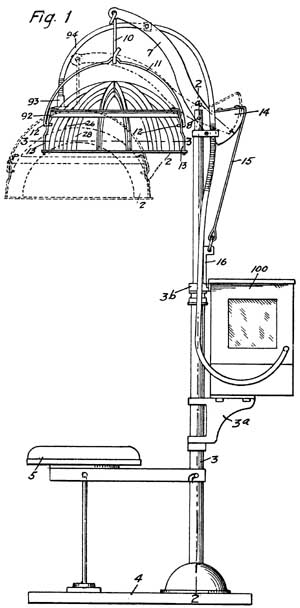Phrenology and the Psycograph
Ellen R.
Kuhfeld, PhD
In 1798, Dr. Franz Joseph Gall first subdivided the brain into 26 areas and
founded the science of phrenology. He assumed the contours of the skull would
reflect the development of the brain beneath, with brain volume related to the
strength of that particular mental function.
 "A large muscle," said Gall and his student Spurzheim, "is
stronger than a smaller one, and a large loadstone is more powerful than a
smaller one; why should it not be the same with the brain?"(1) Gall, Spurzheim,
and their followers set out to measure the cranial configurations of people of
marked character and ability.
"A large muscle," said Gall and his student Spurzheim, "is
stronger than a smaller one, and a large loadstone is more powerful than a
smaller one; why should it not be the same with the brain?"(1) Gall, Spurzheim,
and their followers set out to measure the cranial configurations of people of
marked character and ability.
"I ranged the quarrelsome on one side, and the peaceable on the other, and
examined carefully the heads of both. I found that in all the former the head,
immediately behind and on a level with the top of the ears, was much broader
than in the latter."(2)
The phrenological argument was simple. People had diverse mental capacities
called faculties. These included "the lower propensities or ... the
higher sentiments" as well as "the intellectual powers."(3) These faculties were
localized in the brain. The strength of their expression was related to the size
of that portion of the brain. This in turn affected the contours ("development")
of the surface of the skull.
In short, phrenologists claimed to have found a detailed correlation between
character, ability, and the shape of the skull. Furthermore, they offered to
evaluate the mental and moral characteristics of individuals thereby. They set
it all down as a consistent corpus of charts, drawings, and books. Even their
strongest opponents conceded this straight-forwardness, and agreed phrenology
was amenable to proof or disproof.(4)
Both friends and foes of phrenology agreed it was subject to proof. Both
claimed to have put it to the test and found their view supported. Neither side
won conclusively, and phrenology proved remarkably long-lived.
The strongest argument against phrenology was the propensity of its
practitioners to flatter, and to trim their analyses to the situation and
character of the subject. Even the most impeccably honest phrenologists were
suspect, for the ability of people to see what they expect to see has been
proven throughout history.(5) Lacking was an unimpeachable methodology, accurate
and without bias.
 In short, a "mechanical phrenologist" was needed, one with
no expectations or emotional involvement.
In short, a "mechanical phrenologist" was needed, one with
no expectations or emotional involvement.
Enter Henry C. Lavery, of Superior, Wisconsin. In 1905 he patented just such
a machine. In 1931 (after long development) The Psycograph Company of
Minneapolis was formed to manufacture and distribute it.(6)
The psycograph is in three main units. There is a base, with chair for the
subject and support column for the helmet and printout mechanism. The measuring
helmet is a metal framework with locators to position it repeatably on the head.
There are thirty-two feelers automatically adjusting to the contours of the
skull. Each indicates its position on a five-pole wiper switch. Finally there is
the recording box, housing a mechanism for automatic printout of the readings.
It contains an endless chain of some 160 rubber stamps, and a scanning switch
rotating as the chain cycles through the mechanism. Whenever the scanner
corresponds to the position of one of the skull-feelers, an electrical circuit
is completed. A solenoid-driven hammer pushes the appropriate rubber stamp up
against a paper strip.
The positions of all thirty-two feelers are printed out in less than a
minute, with mini-analyses of that aspect of your personality. An example:
"2 Suavity -- low average -- you do not make enough effort towards
expressing consideration of others. Develop by studying how to please others.
Exercise tact."
 Thirty-three machines were built, and the Minneapolis office
flourished.The machines were leased to entrepreneurs throughout the country for
$2000 down and $35 per month rental. They were a popular traffic-builder for
stores and theaters during the depression.(7)
Thirty-three machines were built, and the Minneapolis office
flourished.The machines were leased to entrepreneurs throughout the country for
$2000 down and $35 per month rental. They were a popular traffic-builder for
stores and theaters during the depression.(7)
The psycograph was used for vocational guidance counseling, as the Fowler
phrenological establishment had been a century earlier. The Fowlers practiced
successfully for decades; the psycograph was used for only a few years. This
shows the phrenological utility of a shrewd judge of character above an unbiased
machine.(8)
Phrenology today is a forgotten fad. Its legacy remains. Modern scientists
study the brain with EEGs, PET scans, SQUID magnetometers, and functional MRI. They trace brain
activity rather than sheer bulk, brain patterns as much as localizations. The
search continues, for areas, volumes, or patterns within the brain, correlated
with mental states and abilities. Researchers still seek out subjects with
extraordinary abilities and handicaps, hoping that extremes will make tendencies
more obvious.
Phrenology, in short, is a mirror-image of alchemy. The alchemists' goals and
patterns of thought are alien to us, and forgotten. The data they collected grew
into the modern science of chemistry. Today the data of phrenology are scorned;
but its goals and procedures are alive in the study of the brain and mind.
This may explain the strangest aspect of the psycograph. Sixty years after it
was manufactured, this embodiment of a bankrupt theory still works well and
reliably. Phrenology, strictly applied, is a rigorous system of thought.
Rigorous thought gives reliable results. The results may be incorrect -- but you
can trust them to be what they are. Lavery took phrenology seriously, and did
his best by it.
References:
1. On the Functions of the Cerebellum, Drs. Gall, Vimont, and
Broussais, translated from the French by George Combe; also Answers to the
Objections Urged against Phrenology, Drs. Roget, Rudolphi, Prichard and
Tiedemann; by George Combe and Sr. A. Combe (Edinburgh, 1838) pg 237
2. Heads and Headlines: The Phrenological Fowlers, by Madeleine B.
Stern, University of Oklahoma Press (Norman, OK, 1971) pg. x
3. Gall, Functions ... (1838) pg 209
4. Ibid, pg 257
5. The Mismeasure of Man, Stephen Jay Gould (New York, 1981)
6. Risse, Guenther B. "Vocational Guidance During the Depression: Phrenology
versus Applied Psychology". J. Hist. Behavioral Sciences 12 (1976)
7. Ibid, pg 137
8. Ibid, pg 131
Home
 "A large muscle," said Gall and his student Spurzheim, "is
stronger than a smaller one, and a large loadstone is more powerful than a
smaller one; why should it not be the same with the brain?"(1) Gall, Spurzheim,
and their followers set out to measure the cranial configurations of people of
marked character and ability.
"A large muscle," said Gall and his student Spurzheim, "is
stronger than a smaller one, and a large loadstone is more powerful than a
smaller one; why should it not be the same with the brain?"(1) Gall, Spurzheim,
and their followers set out to measure the cranial configurations of people of
marked character and ability. In short, a "mechanical phrenologist" was needed, one with
no expectations or emotional involvement.
In short, a "mechanical phrenologist" was needed, one with
no expectations or emotional involvement. Thirty-three machines were built, and the Minneapolis office
flourished.The machines were leased to entrepreneurs throughout the country for
$2000 down and $35 per month rental. They were a popular traffic-builder for
stores and theaters during the depression.(7)
Thirty-three machines were built, and the Minneapolis office
flourished.The machines were leased to entrepreneurs throughout the country for
$2000 down and $35 per month rental. They were a popular traffic-builder for
stores and theaters during the depression.(7)